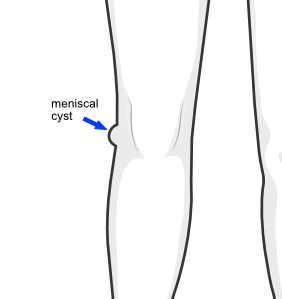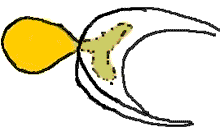Meniscal cysts on the side of the knee are painful and also indicate underlying damage to the meniscus itself.
 First published in 2011, and reviewed August 2023 by Dr Sheila Strover (Clinical Editor)
First published in 2011, and reviewed August 2023 by Dr Sheila Strover (Clinical Editor)
A meniscal cyst is a small balloon-like bulge on the side of the knee originating from a tear within a meniscus.
Anatomy of a meniscal cyst
 Meniscal cysts form on the joint line in close relationship to the meniscus, usually on the lateral (outer) side where they cause pain, where they may be visible. Medical meniscal cysts are rare.
Meniscal cysts form on the joint line in close relationship to the meniscus, usually on the lateral (outer) side where they cause pain, where they may be visible. Medical meniscal cysts are rare.
The cyst is enclosed by a fibrous tissue wall (sac) and filled with joint fluid under pressure. The fluid-filled sac herniates into the capsular tissues on the joint line, producing a painful lump there, which can sometimes be reduced by pressing on the cyst.
What causes meniscal cysts?

Here is a sketch of a crescent-shaped meniscus, with the cyst protruding from it to the side. The dotted line is showing that this cyst communicates with the interior of the meniscus. A cyst forms when trauma damages the interior of the meniscus, causing mucoid degeneration and eventually this may break through to the inner rim of the meniscus as a horizontal cleavage tear. Because of a valve-like action of the opening of the cyst within the meniscus, rather like an oyster, joint fluid is trapped with the defect under pressure, and eventually may force out into the capsular region at the side of the meniscus. Sometimes the fluid escapes back into the joint and the cyst becomes less tense - this can sometimes occur with pressure on the joint lump.
Synovial cells, the ones that line the joint and create the joint fluid, may also find their way into the inside of the cyst and it then creates its own fluid.
Diagnosis of meniscal cysts
Although the diagnosis may be clinically fairly obvious, an MRI scan is likely to clinch the diagnosis as the fluid within the meniscal sac will show up white on MRI scan. Where things get tricky is when a meniscal cyst shows up as an incidental finding, or when it is large and needs to be distinguished from a Baker's cyst.
Cysts of lateral meniscus. Crowell MS, Westrick RB and Fogarty BT. Int J Sports Phys Ther. 2013 Jun; 8(3): 340–348.
Post-traumatic Medial Meniscal Cyst in young: A case report. Herode P, Shroff A, Mandlewala V and Chaudhary A. J Orthop Case Rep. 2016 Jul-Aug; 6(3): 7–9.
Management of meniscal cysts
Usually arthroscopic surgery is performed to exclude the presence of a horizontal cleavage tear of the meniscus. If this is found, the tear is cleaned out and the cyst decompressed from within the meniscus. A partial meniscectomy may be performed.
If there is no horizontal cleavage tear, the cyst may be approached from the outside of the knee and decompressed, and any meniscal rim problem dealt with during surgery.
Imaging-Guided Treatment of Meniscal Cysts. Chang A. HSS J. 2009 Feb; 5(1): 58–60..
PREVIOUS PART: Discoid meniscus
NEXT PART: Surgery for meniscus tears
